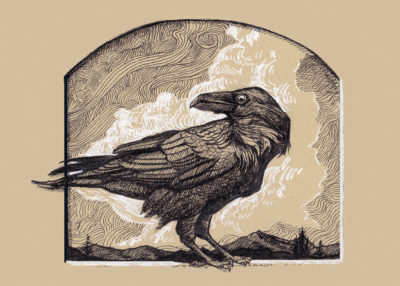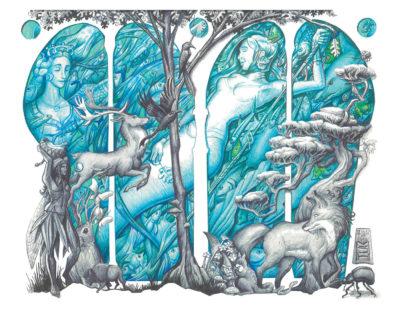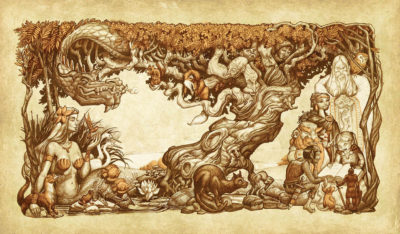
Fox & Raven Studio: Artist Scott Hammond’s Renditions of the Natural and Mythical World Via...
Interviews & Features

M. Scott Hammond of Fox and Raven Studio is best known for his fantastical, fine line–drawn art pieces. Hammond’s love for the natural and visual world grew amid a childhood of climbing trees and pouring over illustrative books. As he studied mythological tales and elaborate encyclopedias in his youth, Hammond would replicate the drawings using a pen. “I spent hours with my nose in books and somehow knew that was the kind of art I wanted to create,” Hammond says. The visual aspect of his imagination was paramount to his relationship with the world and how he placed himself in it as an emerging artist.
While getting his BFA at BYU, Hammond honed his natural sketching abilities into the technical side of creating art. He learned how to draw in a naturalistic and classical fashion, studying the human form in every figure his drawing class made available to him. “They did well [at BYU] to teach you how to make a thing look like that thing,” Hammond says. “I learned the technical aspects [of line drawing], but a lot of the dream world parts got lost.” After college, Hammond freelanced as an artist for Western National Parks and created renditions of the parks via illustration and typography.
“I like seeing how much you can do with the limitation of just using a pen—you can find a lot of creativity within a smaller scope.”
In creating Fox and Raven Studio, Hammond built a platform to showcase both his commissioned work and his personal style without creative constraint. Hammond primarily explores line and texture with black ink, including a little color here and there to add visual intrigue. The pieces

he creates range from small bursts of drawings about 4–5 inches wide to multiple feet of intricate illustrations. “I like seeing how much you can do with the limitation of just using a pen—you can find a lot of creativity within a smaller scope,” Hammond says. The larger pieces are intended to cause the viewer to return to it time and time again, revealing something new with each
encounter. The type of storytelling that detailed, fine–line drawing emotes explores “the subconscious mind, magic and how humanity has related to nature throughout history,” Hammond says. “We have a strict delineation of civilization and nature, even though we are nature.”
“I find the personality of each being in relation to its environment compelling and the idea that trees and rocks have spirits that should be honored.”
Fox and Raven Studio was founded in Tooele, UT, where his great-great-grandfather settled in 1862. Hammond’s Utah-based art pays homage to his appreciation for the landscape itself and the familial ties he has there. His cover for SLUG’s August issue depicts quintessential aspects of the state such as the sego lilies, the pronghorn antelope and the bees that make Utah the “honeybee state.” “When I draw these things, I am meditating on the fur, shapes and textures, but also the way the elements interact with each other,” Hammond says. “I find the personality of each being in relation to its environment compelling and the idea that trees and rocks have spirits that should be honored.” Hammond has also illustrated historic monuments of Ogden and Salt Lake City based on photos he’s taken. The artwork elicited from these places is printed in the studio and is available as postcards and cardstock prints.

As an artist who utilizes various styles of art and techniques, Hammond encourages other artists to do the same. “How we interpret and self-actualize through the world comes from exploring that sense of wonder and imagination we have as kids and translating that into adulthood,” he says.
Hammond provides wholesale prints to boutiques throughout Northern Utah and offers commissions for original illustrations. Find Hammond’s work at art markets all summer long and through the artist’s website at foxandravenstudio.com.
Read about more Salt Lake City artists:
Inevitable Change: Andrea Hardeman’s Abstract Impressionism
Willow Skye-Biggs’ Indeterminate Film Abstractions
